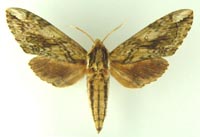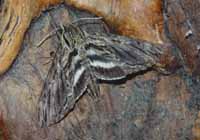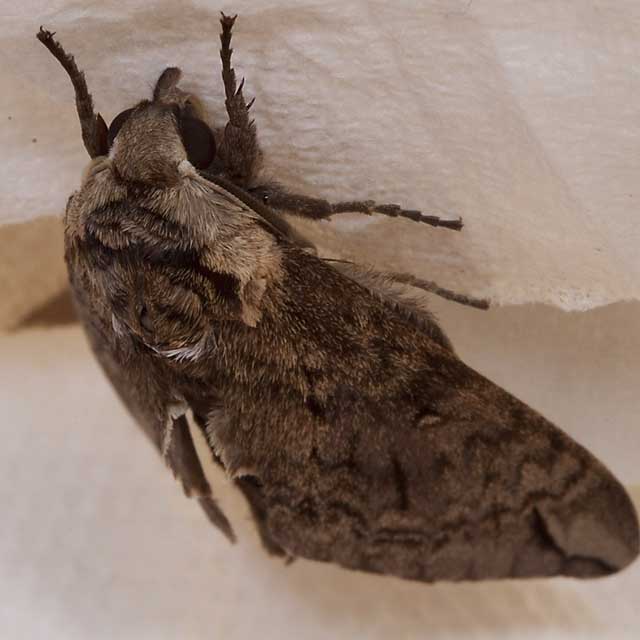Sphinginae subfamily
Sphingini tribe:
 |
Agrius cingulata,
WO Pink-spotted hawkmoth,
stray
This moth is a very strong flier, but would only make its way to
Allen County as a rare stray, possibly late summer or early fall.
|
 |
Ceratomia amyntor WO,
the Elm Sphinx or Four-horned Sphinx
The upperside of the forewing is brown with dark brown and white markings including a white costal area near the wing base,
dark streaks along the veins, and a white spot in the cell. The upperside of the hindwing is light brown and has a dark
brown band along the outer margin.
|
 |
The upperside of the forewing is yellowish brown with no white markings, but there are indistinct black lines
and dashes. The cell spot is gray with a black outline and the upperside of the hindwing is yellowish brown with obscure lines.
|
Ceratomia catalpae pupa found March 29, 2009, Terre Haute, Sandy Scroggins.
 |
Ceratomia hageni
WO,
Hagen's Sphinx or Osage Orange Sphinx
The upperside of the forewing is gray with a green tint and has dark indistinct wavy lines, and pale gray
patches at the wing tip and along the costa. The upperside of the hindwing is dark grayish brown with paler
gray at the base and outer margin.
|
 |
Ceratomia undulosa
WO, the Waved
Sphinx
The upperside of the forewing is pale brownish gray with wavy black and white lines and a black-outlined white cell spot. The upperside of the
hindwing is gray with diffuse darker bands.
Some individuals are very dark, almost black, and others are light yellowish brown.
|
 |
The upperside of the forewing is dark brown with a dusting of white scales. Some moths have patches of reddish or yellowish brown on the wings.
|
 |
Lintneria eremitus WO, the
Hermit Sphinx
The upperside of the forewing is gray-brown with wavy lines, black dashes, and one or two small white spots near
the center of the costa. The upperside of the hindwing is black with two white bands and a triangular black patch at the base.
Note the golden hair on the thorax.
|
 |
The moth abdomen usually has five but sometimes six pairs of yellow bands. The upperside of the forewing is blurry brown and gray.
|
 |
The abdomen usually has six pairs of yellow bands, broken across the back. The sixth set of markings is quite small.
The upperside of the forewing has indistinct black, brown, and white markings.
Larvae get very large and can strip a tomato plant.
|
 | The upperside of the forewing is gray with indistinct black and
white markings. There is a series of black dashes
from the base to the tip, and a small white cell spot.
|

|
Sphinx canadensis
WO,
Sphinx canadensis, the Canadian Sphinx:
The absence of the white spot on each forewing and the more brownish coloration serve to separate canadensis from S. poecilus.
The hindwing fringe also tends to be white on poecilus and checkered brownish on canadensis.
|
 |
Sphinx chersis WO,
the Northern Ash Sphinx or Great Ash Sphinx:
The upperside of the forewing is soft dark gray to blue-gray with a series of black dashes, one of which reaches the wing tip.
The upperside of the hindwing is black with blurry pale gray bands.
|
 |
The forewing costa and terminal areas are pale grey while the rest of the wing is a dark slate grey.
|
 |
Colouration and markings are highly variable from one specimen to another.
The fringes on forewing are mostly black with some white; those on
the hindwing are mostly white with a few black patches.
|
 |
The lower forewings are predominantly brownish-yellow with a fairly wide dark bar along the inner margin.
At rest the wings hug the body, giving the moth a long slender look.
|
Smerinthini Tribe:
 |
The adults are highly variable; sometimes wings of an individual may be all one color or may have several colors,
ranging from pale to dark brown, and may have a white or pink tinge. Patterns range from faint to pronounced.
|
 |
Pachysphinx modesta
WO,
the Modest Sphinx or Poplar Sphinx
Larvae are fond
of poplars and
willows.
They are common on Prince Edward Island.
|
 |
Named for the dull grey-blue spot (minus dark pupil) in the hindwing,
this moth has a wide distribution and is probably common in Allen
County.
I regularly see them on Prince Edward Island, and they are reported
as far south as Florida.
|
 |
Named for the small eye-spot in the hindwing, this moth has a wide distribution
and is probably common in Allen County.
I regularly see them on Prince Edward Island, and they are reported
as far south as Florida.
|
 |
Smerinthus cerisyi
WO, the Cerisyi's
Sphinx or One-eyed Sphinx, Larvae feed on poplars and willows.
Flight would be from late May-July as a single brood.
Questionable, generally more northerly species
|
 |
This moth is widely distributed and fairly common.
Along the East Coast, it flies from P.E.I. to Florida, with many reports from Kentucky and Michigan.
|
Macroglossinae subfamily
Dilophonotini tribe:
See Hemaris comparison
to help distinguish the next three species.
 |
Hemaris diffinis
WO, the
Snowberry Clearwing or Bumblebee Moth:
Hemaris diffinis is a very variable species, but almost always the abdomen sports contrasting black and yellow hairs, the ventral surface being quite black. The
legs also tend to be quite dark and
there is a black mask running across the eye and along the sides of the thorax.
|
 |
Hemaris gracilis
WO, the
Slender Clearwing or Graceful Clearwing:
Hemaris gracilis is distinguished from similar species by a pair of
red-brown bands on the undersides of the thorax, which varies from
green to yellow-green dorsally and sometimes brown with white
underneath. The upper surfaces of abdomen and legs tend to be red.
unlikely, more northerly
|
 |
Hemaris thysbe
USGS, the Hummingbird Clearwing
It is not difficult to see why many gardeners would mistake an Hemaris thysbe moth for a small hummingbird as it hovers,
sipping nectar from flowers through a long feeding tube.
|
Philampelini tribe:
 |
This moth is not officially reported for Allen County, but
has been reported to north, east, south and west.
Note the differences between this moth and the Pandorus Sphinx.
|
 |
If you have Grape or Virginia Creeper nearby, then you probably have
this species.
I often get reports of larvae from outside the reported range.
|
Macroglossini tribe:
 |
This day flier is widely distributed. If you have Virginia Creeper, you
probably have the Nessus Sphinx.
Two bright, distinct, narrow yellow
bands are often visible on the abdomen.
|
 |
They are common in New Jersey and common
here on Prince Edward Island, and they are probably common in Allen Co..
You will often see this species listed as Darapsa pholus,
especially in older literature.
|
 |
Darapsa myron
WO, the Virginia Creeper Sphinx or the Grapevine Sphinx
The forewing upperside is dark brown to pale yellowish gray, with an olive to definite green tint.
On the costal margin there is a dark rectangular patch, although this may be reduced or absent. The upperside of the hindwing is pale orange.
|
 |
Darapsa versicolor
WO,
the Hydrangea Sphinx
The forewing upperside is often greenish brown with curved dark lines and pinkish-white patches.
The hindwing upperside is pale yellow to reddish brown with white along the costal margin, greenish brown along the outer margin, and white shaded with greenish
brown on the inner margin.
|
 |
The moth's outer margin of the forewing is deeply scalloped.
The upperside is light brown with dark brown markings.
There is a small black and white spot near the tip.
The upperside of the hindwing is orange-brown with a dark brown outer margin and median line.
|
 |
Hyles lineata
WO, the White-lined Sphinx
This species has
strong migrating tendancies from much further south.
There are records from New Hampshire, Maine, Michigan, Illinois, etc.
|
 |
This moth is very much under reported across the United States. It
is a rapid day flier so is probably not in too many collections.
Grape is a popular larval host. It is also fond of Virginia Creeper.
|
|
|


